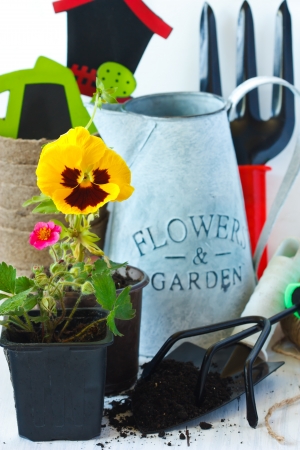Introduction: The Value of Repurposing in American Gardens
Gardening has always been a part of the American way of life, blending practicality with creativity. In recent years, there’s been a renewed appreciation for repurposing household items—turning what might otherwise be discarded into useful, effective garden tools. This approach not only supports sustainability by reducing waste but also helps save money, a win-win for gardeners looking to stretch their budgets. More than just a trend, upcycling is rooted in classic American resourcefulness, echoing the “make do and mend” attitude that’s long defined rural and urban homesteads alike. By reimagining everyday objects for garden use, we honor this tradition while contributing to a greener future—one homemade tool at a time.
Top Household Items To Transform Into Garden Tools
When it comes to DIY gardening, some of the best tools might already be hiding in your recycling bin or kitchen drawers. Repurposing everyday household items not only saves money but also gives a second life to things that would otherwise end up in the landfill. Here are some common household items that can be quickly and easily transformed into practical garden tools for any home gardener.
Milk Jugs
Plastic milk jugs are a versatile staple for DIY garden projects. Their sturdy plastic and convenient handle make them perfect for watering cans, mini-greenhouses, or soil scoops. Simply rinse out a used jug, cut a few holes in the cap, and you have an instant watering can. Cut off the bottom to use as a cloche to protect seedlings from frost or hungry critters.
Old Kitchen Utensils
Before tossing out those worn spatulas or broken forks, consider their new purpose outdoors. Metal spoons make excellent seedling transplanters, while old butter knives can be used as weeding tools. Even slotted spatulas are handy for lifting delicate plants when repotting. Wooden spoons can double as plant markers with a little bit of paint or marker.
Coffee Cans
Coffee cans—whether plastic or metal—are incredibly useful around the garden. They work well as storage containers for seeds, fertilizers, or even harvested produce. With a few holes punched in the bottom, they can become small planters or tool holders. The lids also come in handy for mixing small batches of potting soil or catching runoff water.
Quick Reference Table: Common Household Items & Garden Uses
| Household Item | Garden Use |
|---|---|
| Milk Jug | Watering Can, Mini-Greenhouse, Soil Scoop |
| Old Spoon/Fork | Transplanting Tool, Weeder |
| Butter Knife | Weeding Tool, Soil Loosener |
| Coffee Can | Seed Storage, Planter, Tool Holder |
| Wooden Spoon | Plant Marker |
These easy-to-find household items are just the start. With a little creativity and resourcefulness—hallmarks of any successful American homesteader—you can turn what would be trash into garden treasures that save both time and money.
![]()
3. DIY Step-by-Step: Practical Repurposing Projects
Transforming everyday household items into garden tools isn’t just budget-friendly—it’s an eco-conscious way to add personality and functionality to your garden routine. Here are some easy, hands-on projects to get you started with repurposing, using items you likely already have at home.
Seed Spreaders from Spice Containers
Don’t toss those empty spice jars! After a quick wash, these containers—with their flip-top lids—make perfect seed spreaders. Simply fill the cleaned jar with your chosen seeds. The perforated lid allows for even, controlled distribution when sowing small seeds like lettuce or carrots. Label each container with masking tape or a waterproof marker so you know what’s inside during planting season.
Plant Labels from Old Plastic Cutlery
Plastic forks and spoons left over from takeout meals can be transformed into durable plant markers. Use a permanent marker to write the name of each plant on the handle, then stick the utensil into the soil beside your seedlings. This not only helps keep your garden organized but also keeps plastic waste out of landfills.
Watering Cans from Milk Jugs
A gallon milk jug is an ideal candidate for a DIY watering can. Rinse it thoroughly, then use a nail or small drill bit to poke several holes in the cap. Fill the jug with water, screw the cap back on, and you’re ready to gently water delicate seedlings without disturbing the soil. For larger plants, simply make bigger holes for faster flow.
Bonus Project: Trowel from Old Kitchen Utensils
If you have an old metal spatula or serving spoon lying around, don’t throw it out—turn it into a makeshift trowel for digging and transplanting. Sharpen the edge with a metal file if needed, and wrap the handle with duct tape for comfort and grip. This upcycled tool works especially well for small raised beds or container gardens.
Tip: Get Creative with Paint
Add a splash of color to your repurposed garden tools by painting handles or labeling them in bright shades. Not only does this personalize your gear, but it also helps you spot them easily among foliage or mulch.
4. Safety Tips and Maintenance for DIY Tools
When repurposing household items into garden tools, it’s crucial to prioritize safety and longevity. Proper tool modification and regular maintenance can prevent accidents and help your creations last through many gardening seasons. Here’s what you need to know:
Safe Tool Modifications
Before using any upcycled tool in your garden, make sure it’s safe to handle and fit for the task. Follow these best practices:
- Smooth Rough Edges: Sand down any sharp or jagged edges on metal cans, plastic bottles, or wooden handles to prevent cuts.
- Secure Attachments: Use strong adhesives, sturdy screws, or zip ties to fasten components firmly. Always test the strength before use.
- Choose Non-Toxic Materials: Avoid items that may leach harmful chemicals into your soil—stick with food-safe plastics and untreated wood.
Routine Maintenance Checklist
Just like store-bought tools, your DIY alternatives need regular care. Here’s a simple table to guide your maintenance routine:
| Tool Type | Maintenance Task | Frequency |
|---|---|---|
| Metal Tools (e.g., tin scoops) | Check for rust, clean after use, oil moving parts | Monthly |
| Wood Handles (e.g., broomstick stakes) | Inspect for splinters/cracks, sand as needed, treat with linseed oil | Seasonally |
| Plastic Items (e.g., bottle planters) | Wash thoroughly, check for brittleness or cracks | Every use |
Storage Best Practices
- Store all tools in a dry location to prevent rust or mold growth.
- Hang tools when possible to avoid unnecessary wear and damage.
Troubleshooting Common Issues
- If a handle becomes loose, reinforce it with additional screws or replace the attachment method altogether.
- If plastic parts weaken under sun exposure, consider painting them with UV-protective spray or replacing as needed.
A Final Word on Safety
No matter how ingenious your DIY tool is, always wear appropriate gloves and eye protection during both construction and use. Keeping safety at the forefront ensures your upcycled tools stay helpful—and hazard-free—in your American backyard garden projects.
Engaging Kids and Family in Garden Upcycling
Getting the whole family involved in upcycling household items for garden use isn’t just a practical way to save money—it’s also a fantastic opportunity for building skills, creativity, and lasting memories. Turning everyday objects into useful garden tools can spark curiosity in kids and foster teamwork among family members, all while teaching valuable lessons about sustainability.
Fun and Simple Upcycling Projects for All Ages
Start with easy projects that let children participate from start to finish. For example, transform empty yogurt containers into seedling pots. Kids can decorate the outside with waterproof markers or stickers, then fill them with soil and plant seeds. Old kitchen spoons make excellent hand trowels for little hands, and letting kids personalize them with paint or tape makes the tool uniquely theirs.
Making Memories While Learning New Skills
Repurposing activities aren’t just about the end product—they’re about the process. Assign age-appropriate tasks: younger children can help wash and sort recyclable materials, while older kids can handle safe cutting or drilling with supervision. Building a watering can from a milk jug or fashioning garden markers from popsicle sticks gives everyone a role, boosting confidence and encouraging teamwork.
Connecting With Nature—and Each Other
Upcycling in the garden is more than a weekend project; it’s an ongoing adventure. Take time to talk about why reusing materials matters and how your family’s efforts help reduce waste. Celebrate successes—like the first sprout in a repurposed planter or the satisfaction of using a homemade tool. These small victories turn ordinary afternoons into cherished family traditions rooted in creativity and stewardship.
6. Making the Most of Your Upcycled Tools
Once you’ve created your DIY garden tools from household items, keeping them in top condition is key to getting the most value out of your hard work.
Everyday Tips for Efficiency
To make your upcycled tools last longer and perform better, rinse them off after each use—especially if you’re working with soil or compost. A quick wipe down prevents rust and residue build-up, whether your tool started life as an old spatula or a milk jug scoop. Sharpen edges regularly on tools like repurposed kitchen knives or trowels to maintain their effectiveness.
Proper Storage Matters
Store your DIY tools in a dry spot like a shed or garage, hung up or in containers to keep them organized and prevent accidental damage. If you’re short on space, repurpose an old bucket into a mobile caddy so you can carry all your essentials around the garden easily.
Durability Hacks
For tools made from plastic bottles or containers, reinforce handles with duct tape or wrap them with cloth for extra grip and strength. Wooden handles from broomsticks or old furniture legs can be sanded and treated with linseed oil to resist weathering. Check regularly for signs of wear—like cracks or weakening seams—and repair as needed with glue, screws, or more tape.
When to Upgrade—or Recycle Again
No matter how well you care for your upcycled creations, some will eventually reach the end of their useful life. When a tool starts breaking down beyond simple repair—such as splitting plastic or heavily rusted metal—it’s time to recycle those materials responsibly. Take this as an opportunity to upgrade: sometimes investing in a sturdy store-bought tool is worth it for high-use jobs like digging or pruning, but don’t hesitate to get creative again with new household finds for lighter tasks.
With these practical tips, your homemade garden tools can serve you well season after season, saving money and reducing waste while getting the job done—just like any seasoned American gardener would appreciate.

